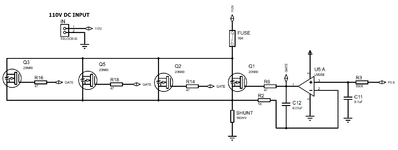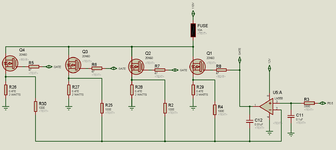gauravkothari23
Advanced Member level 2
Hi all.
I have a project where i have to drop the current from 0.7A to 5A as per the user selection. (Circuit Attached).
As per the circuit. i have interfaced 3 buttons, SET, UP and DOWN for the user to select the amount of current to be grounded.
Am using 220V to 12V SMPS and 7805 Regulator to power the MCU (Not show in circuit diagram)
110V DC INPUT is an external input from where the voltage input would be 110V DC and 25 to 50 Amps of Current.
what my purpose is as soon as the i receive 110V DC input, 0.7A to 5A as per the user selection has to be straight away grounded, for which i am using Mosfet Q1. and shunt resistor. and rest of the current will be sent to 110V DC LOAD OUTPUT.
I am using U3(PC817) to detect 110V DC Input.
I Will control the current to be grounded using PWM and will monitor the current using shunt resistor using ADC pin of MCU.
What my problem is, when the mosfet gets ON during PWM, huge amount of current will flow through the mosfet which will OFF the 110V DC LOAD OUTPUT for a specific period of time.
Can any body please recommened me any idea for how can i do this. or what kind of circuit has to be implemented.

I have a project where i have to drop the current from 0.7A to 5A as per the user selection. (Circuit Attached).
As per the circuit. i have interfaced 3 buttons, SET, UP and DOWN for the user to select the amount of current to be grounded.
Am using 220V to 12V SMPS and 7805 Regulator to power the MCU (Not show in circuit diagram)
110V DC INPUT is an external input from where the voltage input would be 110V DC and 25 to 50 Amps of Current.
what my purpose is as soon as the i receive 110V DC input, 0.7A to 5A as per the user selection has to be straight away grounded, for which i am using Mosfet Q1. and shunt resistor. and rest of the current will be sent to 110V DC LOAD OUTPUT.
I am using U3(PC817) to detect 110V DC Input.
I Will control the current to be grounded using PWM and will monitor the current using shunt resistor using ADC pin of MCU.
What my problem is, when the mosfet gets ON during PWM, huge amount of current will flow through the mosfet which will OFF the 110V DC LOAD OUTPUT for a specific period of time.
Can any body please recommened me any idea for how can i do this. or what kind of circuit has to be implemented.

